Pound Sterling trades flat versus the US Dollar on Tuesday
- The Pound Sterling trades unchanged against the US Dollar as sentiment switches for GBP’s transatlantic currency peer.
- Weak UK data may limit the Pound’s gains, however, as data shows UK shoppers shy away from spending in November.
- Technically, GBP/USD hangs onto its short-term uptrend but remains vulnerable to a reversal.

The Pound Sterling (GBP) trades flat in the 1.2650s on Tuesday as sellers hit pause after the heavy sell-off of the previous day.
GBP/USD’s declined by 0.71% on Monday following tough talk from US President-elect Donald Trump in which he threatened to hit the BRICS trading bloc with 100% tariffs unless it gave up its search for an alternative to the US Dollar. Stronger-than-expected US Purchasing Manager Index (PMI) data further boosted the Buck.
However, it was comments from Federal Reserve (Fed) members, including Fed Governor Christopher Waller, that eventually capped the Greenback’s rally.
Waller said he was leaning “toward supporting a cut in December.” This solidified bets for the Fed cutting interest rates by 25 basis points at its December policy meeting, with the CME FedWatch tool calculating a probability of 76% (from the mid 60s previously). Lower interest rates are negative for currencies as they reduce foreign capital inflows.
Pound Sterling fails to capitalize due to weak fundamentals
The Pound Sterling has struggled to capitalize on the US Dollar’s fumble as UK data disappoints. On Monday, the final reading of the UK PMI in November surprised to the downside, with the Manufacturing PMI falling to a nine-month low of 48.0, from 49.9 in October and below the flash estimate of 48.6.
On Tuesday, the British Retail Consortium’s (BRC) Like-for-Like Retail Sales data provides no relief either. The BRC’s release shows shoppers tightening their belts with a surprise 3.4% drop in sales in November after a 0.3% gain in October, and well below the 0.7% rise expected.
The data adds weight to the view that the Bank of England (BoE) will likely lower interest rates at its December meeting. As such, GBP/USD’s dead-cat bounce looks frail.
Pound Sterling suffers from French contagion
The Pound Sterling has not been spared the malaise emanating from across the channel, either, with UK government bonds (Gilts) selling off after the news that French Prime Minister (PM) Michel Barnier's minority government will face a vote of no confidence by opposition parties opposed to his Budget bill.
The news widened the spread of 10-year Gilt yields over German Bunds to its widest “since Liz Truss was PM, closing at 221.5 bps yesterday,” said Deutsche Bank’s head of macro research Jim Reid in a note on Tuesday morning.
Reid goes on to explain the process that will now unfold for the French government in his note.
“In terms of what happens next, we’re in territory that hasn’t been seen in a long time, as the last successful no-confidence motion was in 1962,” says Reid, adding, “That vote is likely to take place this week, possibly as soon as Wednesday, and assuming it’s successful, that would force the government’s resignation. In the short term, the government can remain in office as a caretaker government.”
New elections will not take place until the summer, however, as the French Constitution requires a one-year wait until another dissolution can take place.
In the meantime, French President Emmanuel Macron will have to propose a new PM, “which could in theory be Barnier again, but there’s no reason to think a new government would be any more stable, given how fractured the National Assembly is,” says Reid.
Regarding the ill-fated Budget, French lawmakers will probably approve a special law authorising the government to collect existing taxes, which it could spend “by decree”.
“However, this would only permit public spending that was part of the 2024 budget, rather than additional expenditures,” adds the strategist.
On the radar
As far as market-moving data for GBP/USD is concerned, the main focus for traders will be US JOLTS jobs data on Tuesday and Fed speakers, including San Francisco Fed President Mary Daly, Fed Governor Adriana Kugler, and Chicago Fed President Austan Goolsbee.
Technical Analysis: Recovers after ABC correction
GBP/USD recovers after Monday’s sell-off in a possible three-wave ABC correction which would mean the pair’s short-term uptrend from the November 22 lows remains intact, albeit by a thread.
Yet, since it is a principle of technical analysis that “the trend is your friend,” the odds continue to favor an extension of this uptrend.
GBP/USD 4-hour Chart
A break above 1.2750 would probably activate the next upside target at around 1.2824, where the (green) 200-period Simple Moving Average (SMA) is situated.
A break below the key support level and the bottom of the ABC correction (thick red dashed line) at 1.2617 would confirm a reversal of the short-term trend. This would likely lead to an extension down to support at 1.2527 followed by 1.2487, the November 22 lows.
The blue Moving Average Convergence Divergence (MACD) indicator has crossed below its red signal line, suggesting more weakness to come.
Although the short-term trend is up, the medium-term trend is still bearish, indicating a risk to the downside if this time frame cycle takes over. To make matters more complicated, the longer-term trend – it could be argued – is still probably bullish.
US Dollar FAQs
The US Dollar (USD) is the official currency of the United States of America, and the ‘de facto’ currency of a significant number of other countries where it is found in circulation alongside local notes. It is the most heavily traded currency in the world, accounting for over 88% of all global foreign exchange turnover, or an average of $6.6 trillion in transactions per day, according to data from 2022. Following the second world war, the USD took over from the British Pound as the world’s reserve currency. For most of its history, the US Dollar was backed by Gold, until the Bretton Woods Agreement in 1971 when the Gold Standard went away.
The most important single factor impacting on the value of the US Dollar is monetary policy, which is shaped by the Federal Reserve (Fed). The Fed has two mandates: to achieve price stability (control inflation) and foster full employment. Its primary tool to achieve these two goals is by adjusting interest rates. When prices are rising too quickly and inflation is above the Fed’s 2% target, the Fed will raise rates, which helps the USD value. When inflation falls below 2% or the Unemployment Rate is too high, the Fed may lower interest rates, which weighs on the Greenback.
In extreme situations, the Federal Reserve can also print more Dollars and enact quantitative easing (QE). QE is the process by which the Fed substantially increases the flow of credit in a stuck financial system. It is a non-standard policy measure used when credit has dried up because banks will not lend to each other (out of the fear of counterparty default). It is a last resort when simply lowering interest rates is unlikely to achieve the necessary result. It was the Fed’s weapon of choice to combat the credit crunch that occurred during the Great Financial Crisis in 2008. It involves the Fed printing more Dollars and using them to buy US government bonds predominantly from financial institutions. QE usually leads to a weaker US Dollar.
Quantitative tightening (QT) is the reverse process whereby the Federal Reserve stops buying bonds from financial institutions and does not reinvest the principal from the bonds it holds maturing in new purchases. It is usually positive for the US Dollar.
Author

Joaquin Monfort
FXStreet
Joaquin Monfort is a financial writer and analyst with over 10 years experience writing about financial markets and alt data. He holds a degree in Anthropology from London University and a Diploma in Technical analysis.


















